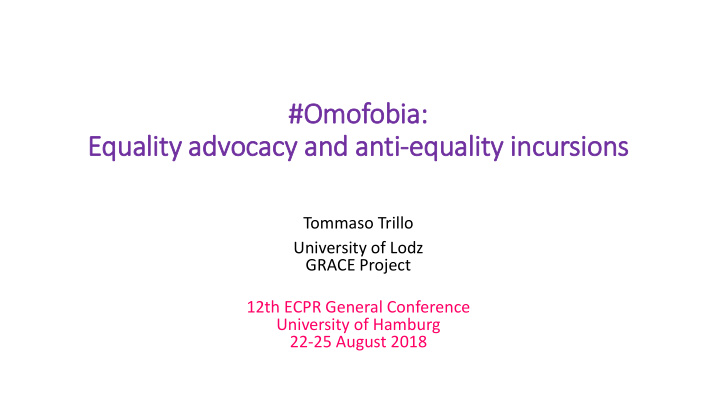



#Omofobia: : Equality advocacy and anti-equality in incursions Tommaso Trillo University of Lodz GRACE Project 12th ECPR General Conference University of Hamburg 22-25 August 2018
Twitter as a space for political engagement Twitter is a micro-blogging platform that allows users to • Create a semi- public profile for themselves and ‘follow’ other users • post short messages known as ‘tweets’ (140 characters, expanded to a 280) • Broadcast their tweets to a community of ‘followers’ • Participate in aggregate conversation on specific topics via ‘hashtags’ The social media platform ‘Twitter’ is owned by the for-profit corporation Twitter Inc., that capitalizes on user’s time and unpaid labor on the platform through different forms of targeted advertising (Fuchs 2013).
Context • The International Day against Homophobia, Transphobia and Biphobia (IDAHOTB) falls every year on May 17th. • The first ‘official’ observance of IDAHOTB (at the time, IDAHO) in 2005 • Transphobia was added to the official name in 2009 • Biphobia was also added in 2015 • IDAHOTB 2017 in Italy mostly featured discussions tied to • First law on same-sex civil unions in 2016 • Law on homophobia stuck in parliament since 2014 • Mounting visibility for anti-equality arguments from the catholic- and far-right • New coalition government headed by a populist right-leaning party and a far-right party
Theoretical roadmap KhosraviNik (2017): Social media – Critical discourse studies (SM-CDS) • Power in discourse and power of discourse operate alongside each other in the context of social media communication • Discourse analysists should account for ‘vertical’ and ‘horizontal’ contextualization Bruns and Burgess (2011): ad hoc publics • Hashtags can serve the purpose of creating and addressing a community of interest concentrated around a specific topic and gathered for the occasion Papacharissi (2015): affective public • Affect rather than affiliation holds together the “community” that forms around an # Fuchs (2011; 2013; 2016): asymmetrical political attention economy of capitalism • Social media do not constitute a public sphere because visibility is unequally distributed • they are colonized by private interests (especially corporations)
Sample • Data gathered from the Twitter hashtag #omofobia (Italian for ‘homophobia’) through the Ncapture web-plugin of Nvivio 11 • One month timespan (May 8 th – June 8 th , 2017) • Leading up to and following IDAHOTB 2017 • A corpus of 7,934 between tweets and retweets
Temporal distribution 4,927 of the tweets gathered were tweeted on the day of IDAHOTB (62% of the dataset) No other peak in activity during the one-month sample
Centralization/decentralization Username category #RTs 238 @vladiluxuria politician 191 @Ri_Ghetto journalist 158 @Simo_Ventura TV host 152 @Radio_Zek Web radio 138 @LaFossettaDiH Blogger 137 @BiblioBastia Public library 129 @PhobiaHomo Blogger 125 @fe_desanctis Journalist 115 Ministry of @MiurSocial Education Traditional elites Public library 91 Pop singer’s @scialpifans fan club Web-based influencers Anti-equality voices
Examples from the dataset Pro-equality Anti-equality Love is beautiful, it is human beings #globaldayagainsthomophobia that suck. #homophobia #loveislove Arcigay: 196 cases of #homophobia in (@Ri_Ghetto, Journalist) Italy, including conferences on #gender [link to FB page] (@nelleNote, anti-equality blogger) TODAY I encountered an Italy against #homophobia and #cyberbullism, but I hope the same for TOMORROW #Homophobia as an excuse to empty (@LaFossettaDiH, blogger) from within not only Chrstian culture, but also freedom of thought On the day against #homophobia, it is [link to facebook page] good to remember that the law has (@sentinpiedi, anti-equality group) been stuck in Parliament for 3years and a half #17May (@fe_desanctis, journalist)
Conclusions • #omofobia was found to be a space where Fuchs (e.g. 2013) • Traditional elites did have the lion share of visibility • Non-traditional elites could find some visibility Khosravinik • Private users mostly figured as ‘audience’ (2017) • Temporality and affectivity were found to be crucial elements in Papacharissi the language adopted by the users involved (2015) • Now-ness essential to tweeted communication • Love, hope, fear, indignation as key in many of the tweets in the corpus • Conversational aspects were hard to detect and probably Bruns and Burgess (2011) scarce, despite the fact that users in favor and against equality adopted the hashtag • Pro-equality users hardly seemed to respond to each other • Anti-equality users did not tweet in conversation with pro-equality users but a the margins
Thank you!!! Tommaso Trillo University of Lodz GRACE Project tommaso.trillo@uni.lodz.pl Twitter: @TommyTrillo
Recommend
More recommend